AZ-204 : Developing Solutions for Microsoft Azure : Part 10
-
HOTSPOT
You are developing an application that uses Azure Storage Queues.
You have the following code:
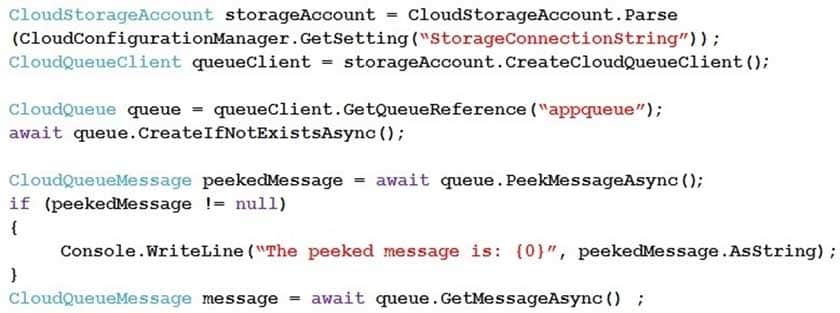
AZ-204 Developing Solutions for Microsoft Azure Part 10 Q01 291 For each of the following statements, select Yes if the statement is true. Otherwise, select No.
NOTE: Each correct selection is worth one point.

AZ-204 Developing Solutions for Microsoft Azure Part 10 Q01 289 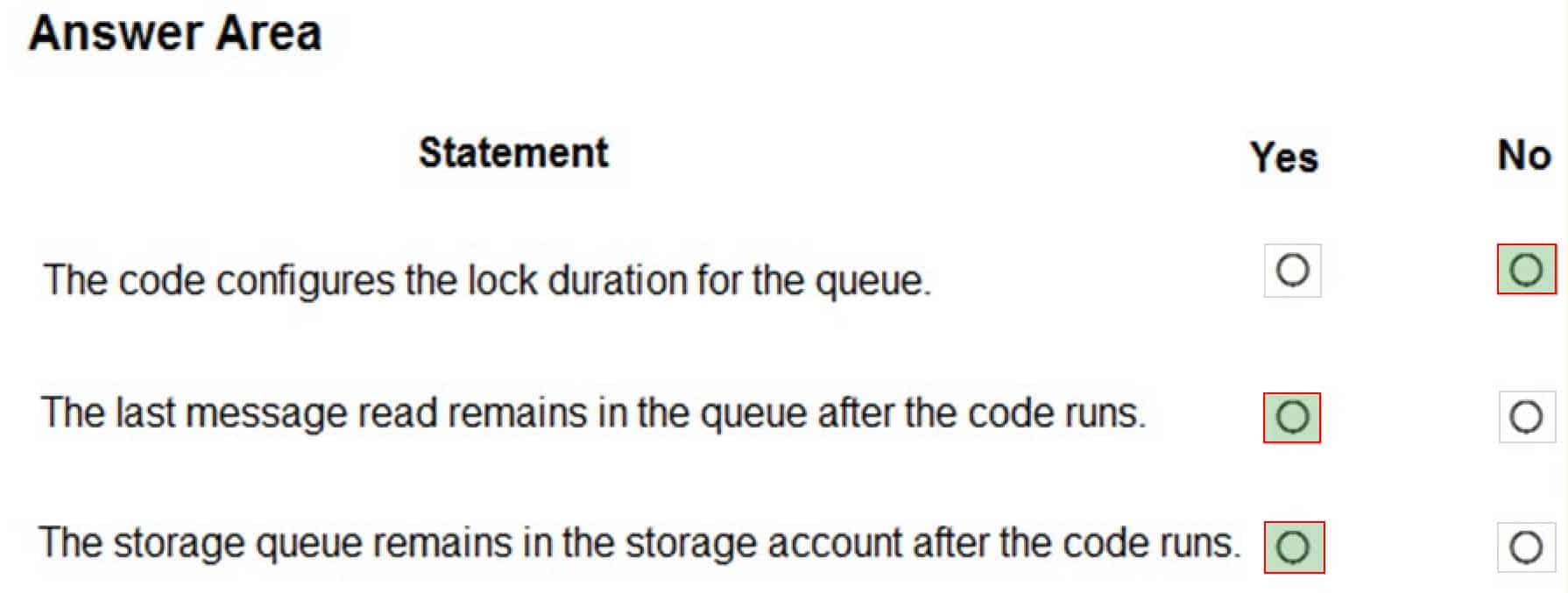
AZ-204 Developing Solutions for Microsoft Azure Part 10 Q01 290 Explanation:Box 1: No
The QueueDescription.LockDuration property gets or sets the duration of a peek lock; that is, the amount of time that the message is locked for other receivers. The maximum value for LockDuration is 5 minutes; the default value is 1 minute.Box 2: Yes
You can peek at the message in the front of a queue without removing it from the queue by calling the PeekMessage method.Box 3: Yes
-
A company is developing a solution that allows smart refrigerators to send temperature information to a central location.
The solution must receive and store messages until they can be processed. You create an Azure Service Bus instance by providing a name, pricing tier, subscription, resource group, and location.
You need to complete the configuration.
Which Azure CLI or PowerShell command should you run?
-

AZ-204 Developing Solutions for Microsoft Azure Part 10 Q02 292 -

AZ-204 Developing Solutions for Microsoft Azure Part 10 Q02 293 -

AZ-204 Developing Solutions for Microsoft Azure Part 10 Q02 294 -

AZ-204 Developing Solutions for Microsoft Azure Part 10 Q02 295
Explanation:A service bus instance has already been created (Step 2 below). Next is step 3, Create a Service Bus queue.
Note:
Steps:
Step 1: # Create a resource group
resourceGroupName=”myResourceGroup”az group create –name $resourceGroupName –location eastus
Step 2: # Create a Service Bus messaging namespace with a unique name
namespaceName=myNameSpace$RANDOM
az servicebus namespace create –resource-group $resourceGroupName –name $namespaceName –location eastusStep 3: # Create a Service Bus queue
az servicebus queue create –resource-group $resourceGroupName –namespace-name $namespaceName –name BasicQueueStep 4: # Get the connection string for the namespace
connectionString=$(az servicebus namespace authorization-rule keys list –resource-group $resourceGroupName –namespace-name $namespaceName –name RootManageSharedAccessKey –query primaryConnectionString –output tsv) -
-
Note: This question is part of a series of questions that present the same scenario. Each question in the series contains a unique solution that might meet the stated goals. Some question sets might have more than one correct solution, while others might not have a correct solution.
After you answer a question in this section, you will NOT be able to return to it. As a result, these questions will not appear in the review screen.
You are developing an Azure Service application that processes queue data when it receives a message from a mobile application. Messages may not be sent to the service consistently.
You have the following requirements:
-Queue size must not grow larger than 80 gigabytes (GB).
-Use first-in-first-out (FIFO) ordering of messages.
-Minimize Azure costs.You need to implement the messaging solution.
Solution: Use the .Net API to add a message to an Azure Storage Queue from the mobile application. Create an Azure Function App that uses an Azure Storage Queue trigger.
Does the solution meet the goal?
- Yes
- No
Explanation:Create an Azure Function App that uses an Azure Service Bus Queue trigger.
-
DRAG DROP
You develop software solutions for a mobile delivery service. You are developing a mobile app that users can use to order from a restaurant in their area. The app uses the following workflow:
1.A driver selects the restaurants for which they will deliver orders.
2.Orders are sent to all available drivers in an area.
3.Only orders for the selected restaurants will appear for the driver.
4.The first driver to accept an order removes it from the list of available orders.You need to implement an Azure Service Bus solution.
Which three actions should you perform in sequence? To answer, move the appropriate actions from the list of actions to the answer area and arrange them in the correct order.

AZ-204 Developing Solutions for Microsoft Azure Part 10 Q04 296 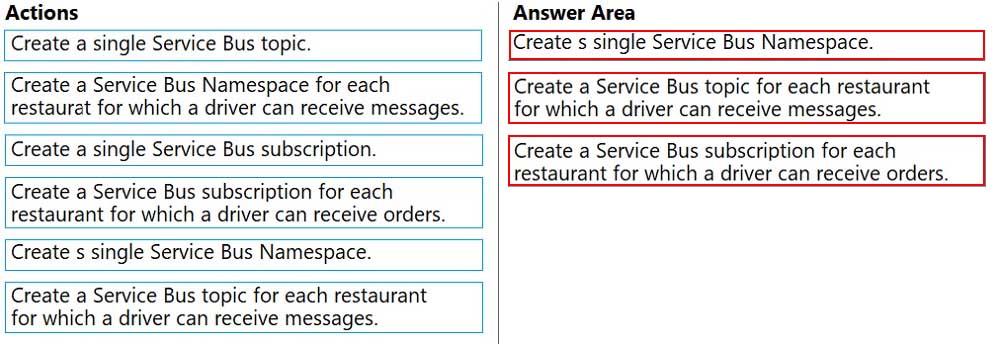
AZ-204 Developing Solutions for Microsoft Azure Part 10 Q04 297 Explanation:Box 1: Create a single Service Bus Namespace
To begin using Service Bus messaging entities in Azure, you must first create a namespace with a name that is unique across Azure. A namespace provides a scoping container for addressing Service Bus resources within your application.Box 2: Create a Service Bus Topic for each restaurant for which a driver can receive messages.
Create topics.Box 3: Create a Service Bus subscription for each restaurant for which a driver can receive orders.
Topics can have multiple, independent subscriptions. -
HOTSPOT
You develop a news and blog content app for Windows devices.
A notification must arrive on a user’s device when there is a new article available for them to view.
You need to implement push notifications.
How should you complete the code segment? To answer, select the appropriate options in the answer area.
NOTE: Each correct selection is worth one point.

AZ-204 Developing Solutions for Microsoft Azure Part 10 Q05 298 
AZ-204 Developing Solutions for Microsoft Azure Part 10 Q05 299 Explanation:Box 1: NotificationHubClient
Box 2: NotificationHubClient
Box 3: CreateClientFromConnectionString
// Initialize the Notification Hub
NotificationHubClient hub = NotificationHubClient.CreateClientFromConnectionString(listenConnString, hubName);Box 4: SendWindowsNativeNotificationAsync
Send the push notification.
var result = await hub.SendWindowsNativeNotificationAsync(windowsToastPayload); -
You are developing an Azure messaging solution.
You need to ensure that the solution meets the following requirements:
-Provide transactional support.
-Provide duplicate detection.
-Store the messages for an unlimited period of time.Which two technologies will meet the requirements? Each correct answer presents a complete solution.
NOTE: Each correct selection is worth one point.
- Azure Service Bus Topic
- Azure Service Bus Queue
- Azure Storage Queue
- Azure Event Hub
Explanation:The Azure Service Bus Queue and Topic has duplicate detection.
Enabling duplicate detection helps keep track of the application-controlled MessageId of all messages sent into a queue or topic during a specified time window.Incorrect Answers:
C: There is just no mechanism that can query a Storage queue and find out if a message with the same contents is already there or was there before.D: Azure Event Hub does not have duplicate detection
-
DRAG DROP
You develop a gateway solution for a public facing news API.
The news API back end is implemented as a RESTful service and hosted in an Azure App Service instance.
You need to configure back-end authentication for the API Management service instance.
Which target and gateway credential type should you use? To answer, drag the appropriate values to the correct parameters. Each value may be used once, more than once, or not at all. You may need to drag the split bar between panes or scroll to view content.
NOTE: Each correct selection is worth one point.

AZ-204 Developing Solutions for Microsoft Azure Part 10 Q07 230 
AZ-204 Developing Solutions for Microsoft Azure Part 10 Q07 231 Explanation:Box 1: Azure Resource
Box 2: Client cert
API Management allows to secure access to the back-end service of an API using client certificates. -
HOTSPOT
You are creating an app that uses Event Grid to connect with other services. Your app’s event data will be sent to a serverless function that checks compliance. This function is maintained by your company.
You write a new event subscription at the scope of your resource. The event must be invalidated after a specific period of time.
You need to configure Event Grid.
What should you do? To answer, select the appropriate options in the answer area.
NOTE: Each correct selection is worth one point.
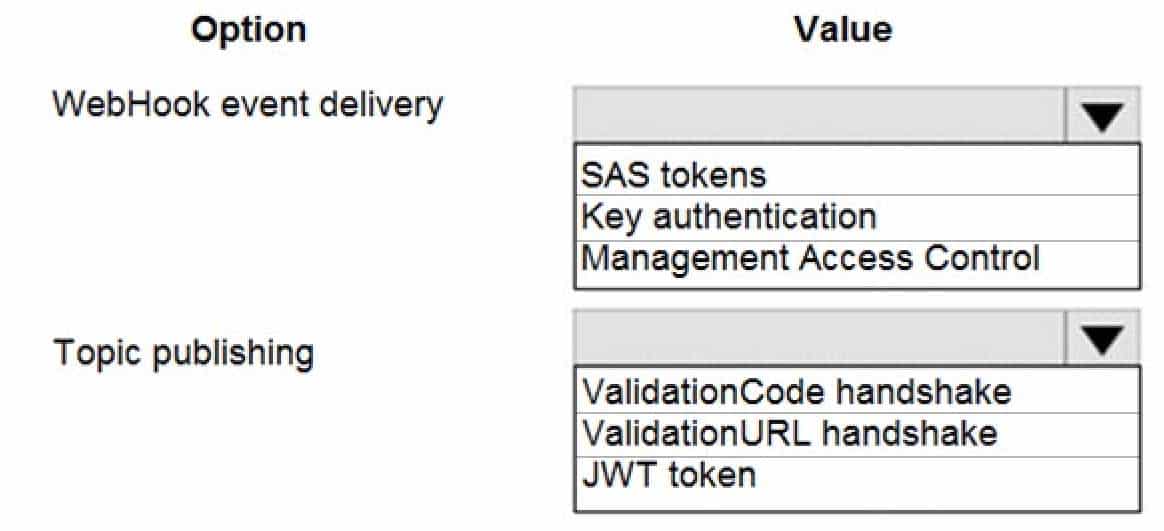
AZ-204 Developing Solutions for Microsoft Azure Part 10 Q08 232 
AZ-204 Developing Solutions for Microsoft Azure Part 10 Q08 233 Explanation:Box 1: SAS tokens
Custom topics use either Shared Access Signature (SAS) or key authentication. Microsoft recommends SAS, but key authentication provides simple programming, and is compatible with many existing webhook publishers.
In this case we need the expiration time provided by SAS tokens.Box 2: ValidationCode handshake
Event Grid supports two ways of validating the subscription: ValidationCode handshake (programmatic) and ValidationURL handshake (manual).
If you control the source code for your endpoint, this method is recommended.Incorrect Answers:
ValidationURL handshake (manual): In certain cases, you can’t access the source code of the endpoint to implement the ValidationCode handshake. For example, if you use a third-party service (like Zapier or IFTTT), you can’t programmatically respond with the validation code. -
HOTSPOT
You are working for Contoso, Ltd.
You define an API Policy object by using the following XML markup:

AZ-204 Developing Solutions for Microsoft Azure Part 10 Q09 234 For each of the following statements, select Yes if the statement is true. Otherwise, select No.
NOTE: Each correct selection is worth one point.

AZ-204 Developing Solutions for Microsoft Azure Part 10 Q09 235 
AZ-204 Developing Solutions for Microsoft Azure Part 10 Q09 236 Explanation:Box 1: Yes
Use the set-backend-service policy to redirect an incoming request to a different backend than the one specified in the API settings for that operation. Syntax: <set-backend-service base-url=”base URL of the backend service” />Box 2: No
The condition is on 512k, not on 256k.Box 3: No
The set-backend-service policy changes the backend service base URL of the incoming request to the one specified in the policy. -
You are developing a solution that will use Azure messaging services.
You need to ensure that the solution uses a publish-subscribe model and eliminates the need for constant polling.
What are two possible ways to achieve the goal? Each correct answer presents a complete solution.
NOTE: Each correct selection is worth one point.
- Service Bus
- Event Hub
- Event Grid
- Queue
Explanation:It is strongly recommended to use available messaging products and services that support a publish-subscribe model, rather than building your own. In Azure, consider using Service Bus or Event Grid. Other technologies that can be used for pub/sub messaging include Redis, RabbitMQ, and Apache Kafka.
-
A company is implementing a publish-subscribe (Pub/Sub) messaging component by using Azure Service Bus. You are developing the first subscription application.
In the Azure portal you see that messages are being sent to the subscription for each topic. You create and initialize a subscription client object by supplying the correct details, but the subscription application is still not consuming the messages.
You need to ensure that the subscription client processes all messages.
Which code segment should you use?
- await subscriptionClient.AddRuleAsync(new RuleDescription(RuleDescription.DefaultRuleName, new TrueFilter()));
- subscriptionClient = new SubscriptionClient(ServiceBusConnectionString, TopicName, SubscriptionName);
- await subscriptionClient.CloseAsync();
- subscriptionClient.RegisterMessageHandler(ProcessMessagesAsync, messageHandlerOptions);
Explanation:Using topic client, call RegisterMessageHandler which is used to receive messages continuously from the entity. It registers a message handler and begins a new thread to receive messages. This handler is waited on every time a new message is received by the receiver.
subscriptionClient.RegisterMessageHandler(ReceiveMessagesAsync, messageHandlerOptions);
-
Note: This question is part of a series of questions that present the same scenario. Each question in the series contains a unique solution that might meet the stated goals. Some question sets might have more than one correct solution, while others might not have a correct solution.
After you answer a question in this section, you will NOT be able to return to it. As a result, these questions will not appear in the review screen.
You are developing an Azure Service application that processes queue data when it receives a message from a mobile application. Messages may not be sent to the service consistently.
You have the following requirements:
-Queue size must not grow larger than 80 gigabytes (GB).
-Use first-in-first-out (FIFO) ordering of messages.
-Minimize Azure costs.You need to implement the messaging solution.
Solution: Use the .Net API to add a message to an Azure Storage Queue from the mobile application. Create an Azure VM that is triggered from Azure Storage Queue events.
Does the solution meet the goal?
- Yes
- No
Explanation:Don’t use a VM, instead create an Azure Function App that uses an Azure Service Bus Queue trigger.
-
Note: This question is part of a series of questions that present the same scenario. Each question in the series contains a unique solution that might meet the stated goals. Some question sets might have more than one correct solution, while others might not have a correct solution.
After you answer a question in this section, you will NOT be able to return to it. As a result, these questions will not appear in the review screen.
You are developing an Azure Service application that processes queue data when it receives a message from a mobile application. Messages may not be sent to the service consistently.
You have the following requirements:
-Queue size must not grow larger than 80 gigabytes (GB).
-Use first-in-first-out (FIFO) ordering of messages.
-Minimize Azure costs.You need to implement the messaging solution.
Solution: Use the .Net API to add a message to an Azure Service Bus Queue from the mobile application. Create an Azure Windows VM that is triggered from Azure Service Bus Queue.
Does the solution meet the goal?
- Yes
- No
Explanation:Don’t use a VM, instead create an Azure Function App that uses an Azure Service Bus Queue trigger.
-
DRAG DROP
You are developing a REST web service. Customers will access the service by using an Azure API Management instance.
The web service does not correctly handle conflicts. Instead of returning an HTTP status code of 409, the service returns a status code of 500. The body of the status message contains only the word conflict.
You need to ensure that conflicts produce the correct response.
How should you complete the policy? To answer, drag the appropriate code segments to the correct locations. Each code segment may be used once, more than once, or not at all. You may need to drag the split bar between panes or scroll to view content.
NOTE: Each correct selection is worth one point.
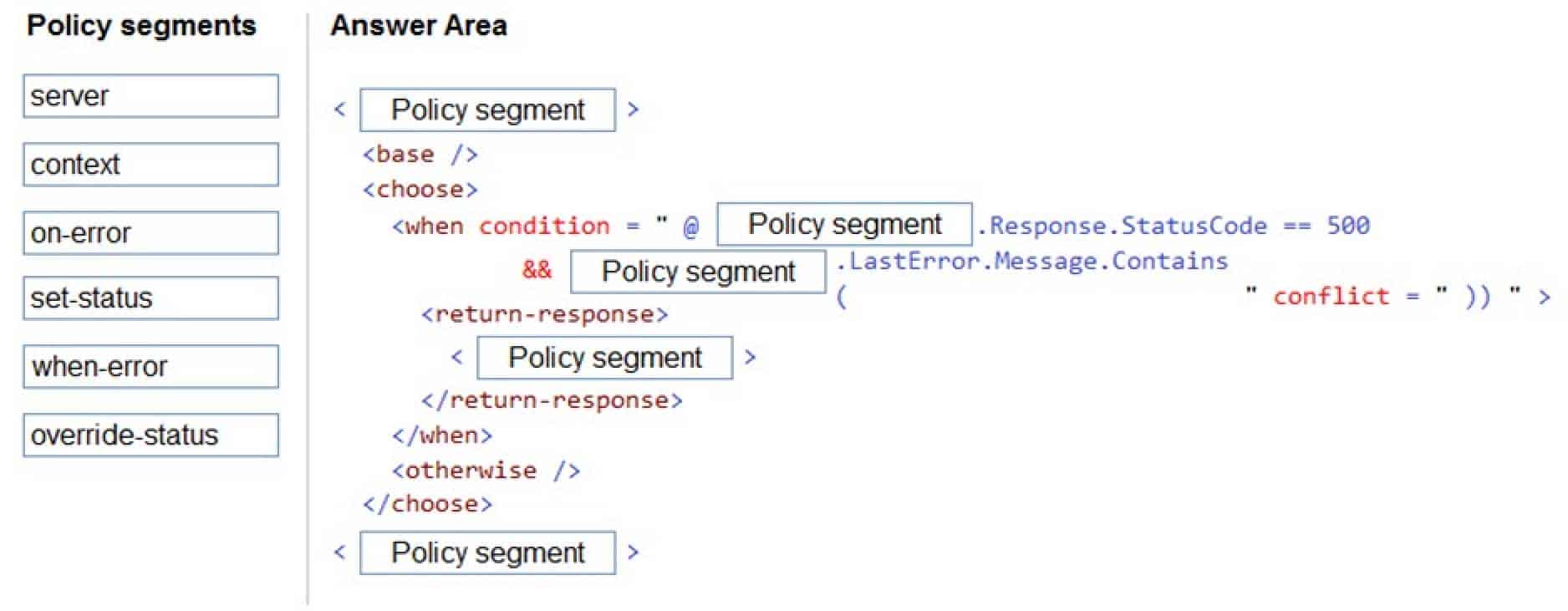
AZ-204 Developing Solutions for Microsoft Azure Part 10 Q14 237 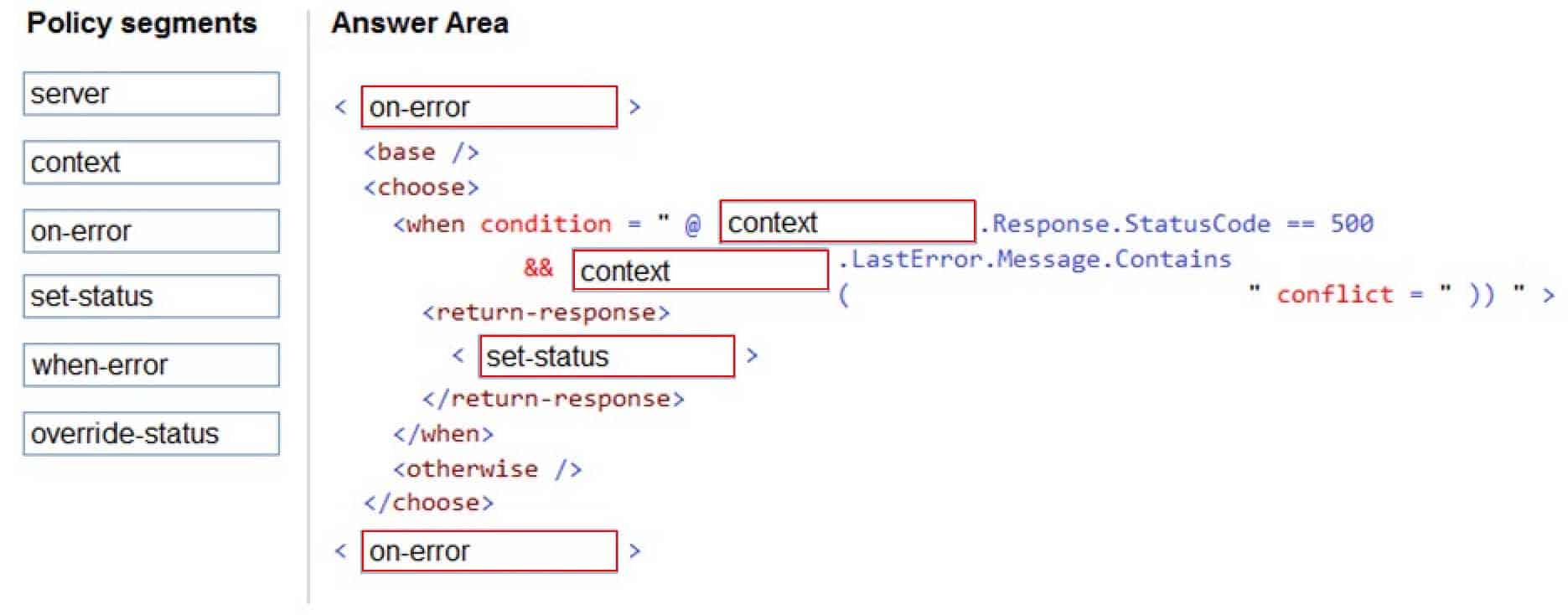
AZ-204 Developing Solutions for Microsoft Azure Part 10 Q14 238 Explanation:Box 1: on-error
Policies in Azure API Management are divided into inbound, backend, outbound, and on-error.
If there is no on-error section, callers will receive 400 or 500 HTTP response messages if an error condition occurs.Box 2: context
Box 3: context
Box 4: set-status
The return-response policy aborts pipeline execution and returns either a default or custom response to the caller. Default response is 200 OK with no body.
Custom response can be specified via a context variable or policy statements.
Syntax:
<return-response response-variable-name=”existing context variable”>
<set-header/>
<set-body/>
<set-status/>
</return-response>Box 5: on-error
-
DRAG DROP
You are a developer for a Software as a Service (SaaS) company. You develop solutions that provide the ability to send notifications by using Azure Notification Hubs.
You need to create sample code that customers can use as a reference for how to send raw notifications to Windows Push Notification Services (WNS) devices. The sample code must not use external packages.
How should you complete the code segment? To answer, drag the appropriate code segments to the correct locations. Each code segment may be used once, more than once, or not at all. You may need to drag the split bar between panes or scroll to view content.
NOTE: Each correct selection is worth one point.

AZ-204 Developing Solutions for Microsoft Azure Part 10 Q15 239 
AZ-204 Developing Solutions for Microsoft Azure Part 10 Q15 240 Explanation:Box 1: windows
Example code:
var request = new HttpRequestMessage(method, $”{resourceUri}?api-version=2017-04″);
request.Headers.Add(“Authorization”, createToken(resourceUri, KEY_NAME,
KEY_VALUE));
request.Headers.Add(“X-WNS-Type”, “wns/raw”);
request.Headers.Add(“ServiceBusNotification-Format”, “windows”);
return request;Box 2: application/octet-stream
Example code capable of sending a raw notification:
string resourceUri = $”https://{NH_NAMESPACE}.servicebus.windows.net/{HUB_NAME}/messages/”;
using (var request = CreateHttpRequest(HttpMethod.Post, resourceUri))
{
request.Content = new StringContent(content, Encoding.UTF8,
“application/octet-stream”);
request.Content.Headers.ContentType.CharSet = string.Empty;
var httpClient = new HttpClient();
var response = await httpClient.SendAsync(request);
Console.WriteLine(response.StatusCode);
} -
Note: This question is part of a series of questions that present the same scenario. Each question in the series contains a unique solution that might meet the stated goals. Some question sets might have more than one correct solution, while others might not have a correct solution.
After you answer a question in this section, you will NOT be able to return to it. As a result, these questions will not appear in the review screen.
You are developing an Azure solution to collect point-of-sale (POS) device data from 2,000 stores located throughout the world. A single device can produce 2 megabytes (MB) of data every 24 hours. Each store location has one to five devices that send data.
You must store the device data in Azure Blob storage. Device data must be correlated based on a device identifier. Additional stores are expected to open in the future.
You need to implement a solution to receive the device data.
Solution: Provision an Azure Event Hub. Configure the machine identifier as the partition key and enable capture.
Does the solution meet the goal?
- Yes
- No
-
DRAG DROP
You are developing an Azure solution to collect inventory data from thousands of stores located around the world. Each store location will send the inventory data hourly to an Azure Blob storage account for processing.
The solution must meet the following requirements:
-Begin processing when data is saved to Azure Blob storage.
-Filter data based on store location information.
-Trigger an Azure Logic App to process the data for output to Azure Cosmos DB.
-Enable high availability and geographic distribution.
-Allow 24-hours for retries.
-Implement an exponential back off data processing.You need to configure the solution.
What should you implement? To answer, select the appropriate options in the answer area.
NOTE: Each correct selection is worth one point.

AZ-204 Developing Solutions for Microsoft Azure Part 10 Q17 241 
AZ-204 Developing Solutions for Microsoft Azure Part 10 Q17 242 Explanation:Box 1: Azure Event Grid
Blob storage events are pushed using Azure Event Grid to subscribers such as Azure Functions, Azure Logic Apps, or even to your own http listener. Event Grid provides reliable event delivery to your applications through rich retry policies and dead-lettering.Box 2: Azure Logic App
Event Grid uses event subscriptions to route event messages to subscribers. This image illustrates the relationship between event publishers, event subscriptions, and event handlers.
AZ-204 Developing Solutions for Microsoft Azure Part 10 Q17 243 Box 3: Azure Service Bus
The Event Grid service doesn’t store events. Instead, events are stored in the Event Handlers, including ServiceBus, EventHubs, Storage Queue, WebHook endpoint, or many other supported Azure Services. -
You are creating an app that will use CosmosDB for data storage. The app will process batches of relational data.
You need to select an API for the app.
Which API should you use?
- MongoDB API
- Table API
- SQL API
- Cassandra API
Explanation:For relational data you will need the SQL API
Incorrect Answer:
A: The MongoDB API is not used for relational data.
B: The Table API only supports data in the key/value format
D: The Cassandra API only supports OLTP (Online Transactional Processing) and not batch processing. -
HOTSPOT
You are developing a .NET application that communicates with Azure Storage.
A message must be stored when the application initializes.
You need to implement the message.
How should you complete the code segment? To answer, select the appropriate options in the answer area.
NOTE: Each correct selection is worth one point.

AZ-204 Developing Solutions for Microsoft Azure Part 10 Q18 244 
AZ-204 Developing Solutions for Microsoft Azure Part 10 Q18 245